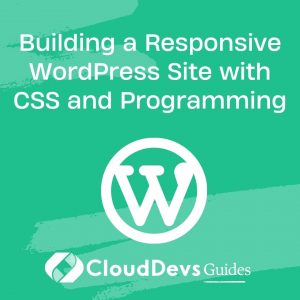Building a Responsive WordPress Site with CSS and Programming
In today’s digital landscape, a website’s responsiveness is paramount. With an ever-increasing number of users accessing websites through various devices, creating a responsive website has become essential. WordPress, being one of the most popular content management systems, offers a solid foundation for building responsive websites. In this guide, we’ll explore the process of building a responsive WordPress site using CSS and programming techniques.
Table of Contents
1. Why Responsive Design Matters
Responsive web design ensures that your website’s layout and content adapt seamlessly to different screen sizes, resolutions, and orientations. This improves user experience, reduces bounce rates, and enhances your site’s search engine rankings. With the increasing use of smartphones and tablets, neglecting responsive design could lead to losing a significant portion of your potential audience.
2. The Role of CSS in Responsive Design
Cascading Style Sheets (CSS) is a crucial tool for achieving responsive design in WordPress. CSS allows you to control the appearance and layout of your website, making it adaptable to various screen sizes.
2.1. Media Queries: Adapting to Different Devices
Media queries are CSS rules that apply styles based on the user’s device characteristics. By defining different styles for various screen widths, you can create a fluid design that adjusts gracefully to any device. Here’s an example of a media query in CSS:
css
@media screen and (max-width: 768px) {
/* Styles for screens up to 768px */
}
2.2. Flexbox and Grid Layouts: Flexible Content Arrangement
Flexbox and CSS Grid Layout are modern layout techniques that enable you to create flexible and responsive content arrangements. Flexbox is particularly useful for building one-dimensional layouts, while CSS Grid Layout offers a two-dimensional grid system.
Flexbox Example:
css
.container {
display: flex;
flex-direction: row;
justify-content: space-between;
}
CSS Grid Example:
css
.container {
display: grid;
grid-template-columns: repeat(3, 1fr);
gap: 20px;
}
3. Programming Techniques for Responsiveness
In addition to CSS, programming techniques play a vital role in building a responsive WordPress site. Plugins and custom code allow you to enhance responsiveness and user interactions.
3.1. Mobile-First Approach: Designing for Smaller Screens
Adopting a mobile-first approach means designing and developing for mobile devices first and then progressively enhancing the layout for larger screens. This approach ensures a seamless experience on all devices.
3.2. Custom JavaScript for Interactions
JavaScript can be used to create interactive elements that enhance user engagement and responsiveness. For example, you can use JavaScript to implement a navigation menu that collapses into a mobile-friendly icon on smaller screens.
javascript
const menuButton = document.querySelector('.menu-button');
const menuList = document.querySelector('.menu-list');
menuButton.addEventListener('click', () => {
menuList.classList.toggle('active');
});
4. Implementing Responsive Design in WordPress
Now that we’ve covered the foundational concepts, let’s delve into implementing responsive design in a WordPress site.
4.1. Choose a Responsive Theme
Selecting a responsive WordPress theme is the first step toward building a responsive site. Look for themes that explicitly mention their responsiveness in their description. Many modern WordPress themes are built with mobile-first principles and incorporate responsive design out of the box.
4.2. Optimize Images for Different Screens
Large images can slow down your website and disrupt the user experience, especially on mobile devices. Use image optimization techniques and consider using the srcset attribute to provide different image sizes for different screen resolutions.
html
<img src="image.jpg"
srcset="image-480w.jpg 480w,
image-768w.jpg 768w,
image-1024w.jpg 1024w"
sizes="(max-width: 480px) 100vw,
(max-width: 768px) 80vw,
1024px">
4.3. Utilize WordPress Plugins
WordPress offers a wide range of plugins that can assist in making your site responsive. Plugins like “WPtouch” can help create a mobile-friendly version of your site, while “Smush” can automatically optimize and compress images for better performance.
5. Testing and Optimizing
Building a responsive WordPress site is only half the battle; thorough testing is essential to ensure your site functions flawlessly across various devices.
5.1. Cross-Device and Browser Testing
Use real devices and popular browsers to test your site’s responsiveness. This step helps identify any issues that may arise on specific devices or browsers and ensures a consistent experience.
5.2. Performance Optimization
Page speed is crucial for user satisfaction and SEO. Use tools like Google PageSpeed Insights to identify performance bottlenecks and implement optimizations like caching, minification, and lazy loading.
Conclusion
In today’s mobile-centric world, a responsive website is a necessity, not a luxury. Building a responsive WordPress site involves leveraging the power of CSS and programming techniques to create an adaptable and user-friendly experience on all devices. From media queries to JavaScript interactions, each aspect plays a vital role in crafting a seamless user journey. By following best practices, selecting the right theme, optimizing images, and testing rigorously, you can ensure your WordPress site not only looks great but also functions impeccably across the entire spectrum of devices. So, roll up your sleeves, apply these techniques, and watch your WordPress site thrive in the responsive era.
Table of Contents








